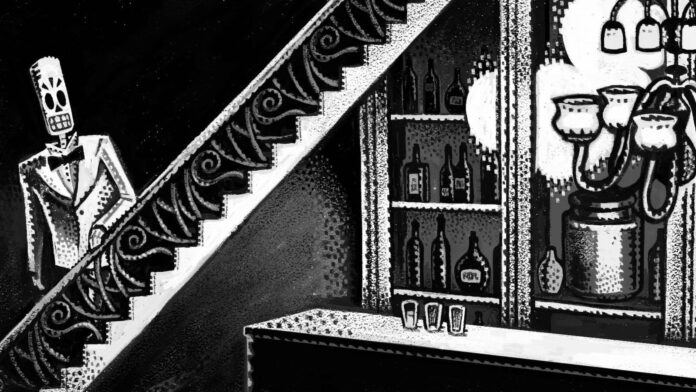Death. “The greatest of all human blessings” according to Socrates, “a very dull and dreary affair” to W. Somerset Maugham, and “always around the corner” as observed by Carter Burwell. But, ultimately, the inevitability of all living beings. It is the one experience that is guaranteed and that the human brain will never truly know fully: both accepted and incomparably frightening.
Death has been explored in countless mediums since humanity first began to explore artistic expression and creation, often drawing on commonly recognised beliefs or customs and the representation of the soul. In gaming, the act of death and being dead has often been utilised as a theme, a conclusion, a key plot element, or a shocking twist. And games that explore the state of being dead, while adding original tweaks, even now still tend to veer towards spirits, ghosts, and similarly ethereal beings. This was certainly the go-to in the ’90s during the growth of 3D gaming, following that commonly recognised imagery. Particular cultures were rarely explored. Until 1998, when Tim Schafer’s second solo venture crossed over and hit the stores.
Land of the Dead noir adventure Grim Fandango was an instant hit with both critics and players alike, taking home a mountain of gaming awards in 1998. Almost 25 years later and it is still often regarded as one of the greatest video games of all time. If there’s a list, it’s a good bet that Grim Fandango will be on it. Art direction, dialogue, puzzles, all these and more were noted as points of excellence, as well as its specially created GrimE engine. However, despite these bountiful accolades, the initial profits sadly did not echo the praise. In a kind of bittersweet irony, Grim Fandango appeared to signal the decline – or death – of the adventure game genre. But, considering the ever-growing number of indie adventure titles and the release of Grim Fandango Remastered in 2015, it also signalled its own cult classic status, and the rebirth of the genre. Impossible, one would imagine. But Tim Schafer and LucasArts managed to achieve this by tapping into something that is still only just being properly realised: the respectful exploration of culture.
Mexican and Mesoamerican culture in media – and indeed many indigenous cultures – generally veered towards stereotypes, particularly at the time of release. Used primarily for comic relief, representation usually only extended as far as giving a character a sombrero, a poncho, and a borderline blasphemous accent. A move that was hollow, tacky at best, and a sweeping generalisation that Schafer was keen to avoid. Instead, he started with the Mexican tradition of Día de los Muertos and Aztec folklore surrounding death as the epicentre, and allowed the story to develop by delving into its many facets. The approach was not “How can this theme be fitted into the narrative?” but rather “What kind of world-building and storytelling techniques would best explore this theme recognisably and respectfully?” Given the fact that a cinematic feel was desired, there are few tropes and styles more recognisable in cinema than film noir. Even if a person cannot attest to seeing the likes of Casablanca or The Maltese Falcon, a shadowed face under a fedora, a striking woman wreathed in smoke from a long cigarette holder, and the lingering notes of a saxophone are universal.
In Mexican folklore, people were buried with two bags of gold to carry over into the afterlife, similar to the ancient Greek tradition of coins over the eyes to pay the ferryman. One bag was placed upon the chest, the other hidden in their coffin should the first be stolen by opportunistic spirits. This criminal element combined with the backbone of the Aztec underworld of Mictlan and the journey of the soul lent itself perfectly to the noir world of gangsters, everymen, and intrigue. The blending of Aztec and Mexican iconography with styles from the art deco movement created a visual style that was somehow both unique and beautifully familiar. Even the design of the skeletal residents of the Land of the Dead were so rooted in authenticity that it prompted a change in graphical approach. Being modelled from ‘calacas’ figures commonly used in Día de los Muertos celebrations, the development team had to envision how these would work three-dimensionally within scenes. Subsequently, the static backgrounds and character animations were moulded to accommodate them.
No exciting noir adventure is complete without death, of course, even in the Land of the Dead! But how would the dead die in the underworld with no earthly bodies to suffer wounds or illness? Here, another cultural melding was used to exemplary effect. In Día de los Muertos and Aztec funeral rites, flowers are used in abundance – notably marigolds for the former – for adornment and decoration. Beyond the living world, however, if the seeds of these vibrant blooms are injected, roots and flowers begin to burst forth, engulfing the bones until they eventually disintegrate into dust. This is the deadlier-than-deadly process of ‘sprouting’, described by character Sal Limones as “a horrifying bouquet of pain and fragrant suffering.” In the same way some wayward spirits would help themselves to a recently departed soul’s gold, the undead antagonists – primarily crime lord Hector LeMans – will use this hyper-advancement of nature to better their own afterlife.
An adventure itself is often about the journey, the events that occurred throughout the passage of time. However, in most adventure games, the passing of time was seldom integrated into the central narrative itself. Commonly, the inference would be used as a cartoony jab to speed up a long and boring speech or segment, or perhaps be mentioned over a course of narration. But rarely would there be any significant changes to the characters themselves or the world around them; the story could be taking place the following day. In Grim Fandango, time is part of the journey; the pilgrimage a soul must take to eternal rest lasts four years on foot and each chapter encompasses one year. Though punctuated with a title card, in this time, the protagonists and supporting cast go through substantial changes in circumstance, appearance, and perspective. The player can see how far a character has come or how much they have endured in that year through visual, gameplay, and vocal means.
Naturally, meticulous care was given to the voice performances bringing the populace of the Land of the Dead to life, so to speak. A decision Schafer had set in stone from the beginning, the voice cast was largely made up of Latino actors: Tony Plana and Maria Canals-Barrera playing protagonists Manny Calavera and Mercedes ‘Meche’ Colomar. Plana helped flesh out much of Manny and other characters’ dialogue. Being a fluent Spanish speaker, he would suggest alternative phrases or words that would be more natural in Spanish conversation – a move that truly paid off. There is a real fluidity and a natural feel to the dialogue, interspersed with sparks of Spanish that never feel out of place or overemphasised. Even if a player does not necessarily understand the word or phrase, the essence of the dialogue is still maintained.
From this foundational fluidity came organic humour and interactions – conversational gold for an adventure game! In 2018, Schafer and the principal cast reunited at E3 for a live reading of Grim Fandango scenes backed by storyboard artwork, and the dialogue was as full of natural spark and wit as it was when it was first recorded. On a simple stage with the cast seated on chairs reading from a script, Manny, Meche, and the Land of the Dead was effortlessly evoked.
.jpg/BROK/resize/690%3E/format/jpg/quality/75/thumbnail_Fandango---rusty-anchor3-(1).jpg)
Schafer once said of noir cinema: “There’s something that I feel is really honest about the way people talk that’s different than modern movies.” This is particularly reflected in the working everyman characters like Manny and his day-to-day existence in the Land of the Dead. The four year journey of the soul in Mictlan is arduous and full of trials, particularly for those who have not performed good deeds in life. For many, it is too much and they lose faith in the existence of the paradise beyond. From this was sparked the idea that these souls take up jobs and vocations within this noir limbo. As The Grim Reaper, Manny is simply a travel agent, selling various Ninth Underworld travel packages to clients depending on the purity of their existence. If you’re on a par with a certain Senor Celso, it’s a compass on a stick for you – sorry, I mean, ‘The Excelsior Line’! He puts his nose to the grindstone (or would if he had one) until he finds an opportunity to move forward in the world and take his shot at paradise – all whilst making the most of every chance to make sarcastic barbs along the way.
In Grim Fandango, time is part of the journey; the pilgrimage a soul must take to eternal rest lasts four years on foot and each chapter encompasses one year.
Despite the bleak mundane picture it paints for Manny and his fellow residents, there is an underlying feel of familiarity for the player – the familiarity of everyday life. Even the most adventurous soul can feel a degree of comfort from habitual things and find humour in them. Mexican poet Octavio Paz said “To the people of New York, Paris, or London, ‘death’ is a word that is never pronounced because it burns the lips. The Mexican…is familiar with death. [He] jokes about it, caresses it, sleeps with it, celebrates it. It is one of his favourite toys and his most steadfast love.” In its melding of genres, traditions, and cultures, Grim Fandango managed to share a little of this frame of mind with the rest of the world.
Through Manny Calavera’s four year journey to soul’s rest, one can almost feel acquainted with the end, and more at ease. Reflected in the reverence of culture at Grim Fandango’s heart is the journey of the adventure genre as a whole. Soon after its release, it went into decline, facing trials and tribulations, slumps and failures along the way. At any point, it could have been sprouted and disappeared for good. But developers kept to their course with their own Excelsior Lines and pressed on. And sure enough, thanks to a certain undead venture from Telltale Games, the gates of the Ninth Underworld came into view.
The taste for the genre was reignited; Grim Fandango and adventure games were reborn.
This piece comes from the forthcoming issue of the ever brilliant [lock-on] – you can find out more and pick up a copy here.
www.eurogamer.net






